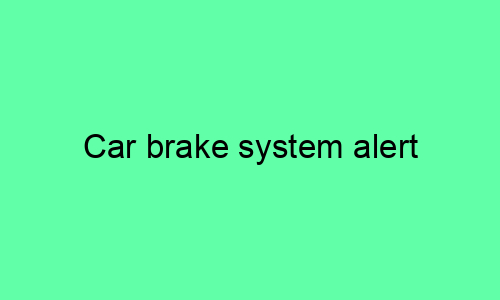## Car Brake System Alert: A Comprehensive Guide to Warning Signs and Maintenance
### Introduction
The brake system is arguably the most important safety feature on a vehicle, enabling drivers to control their speed, prevent collisions, and avoid accidents. To ensure optimal performance and safety, it’s crucial to be aware of the signs that indicate potential problems with the brake system and to take prompt action.
### Warning Signs of a Failing Brake System
**1. Spongy or Soft Brake Pedal**
A spongy or soft brake pedal feels mushy and requires more force to engage the brakes. This often indicates air in the brake lines or a leak in the brake fluid.
**2. Hard or Stiff Brake Pedal**
A hard or stiff brake pedal requires excessive force to engage the brakes. This can be caused by a faulty vacuum assist system or worn brake pads.
**3. Squealing or Grinding Noises**
Squealing or grinding noises while braking usually indicate worn brake pads or rotors. It’s essential to replace brake pads before the friction material gets too thin and damages the rotors.
**4. Pulling to One Side**
If the vehicle pulls to one side while braking, it may indicate a problem with the brake caliper or brake line on that side. Uneven braking force can cause premature wear and tear on the affected components.
**5. Vibration in the Steering Wheel**
Vibration in the steering wheel while braking can be a symptom of warped or uneven brake rotors. It’s important to have the rotors inspected and replaced if necessary to restore smooth braking.
**6. Brake Fluid Leakage**
Brake fluid leakage can lead to a loss of hydraulic pressure in the brake system, resulting in decreased braking performance. Check the brake fluid level and inspect the lines and components for leaks.
**7. Brake Light Warning**
Most vehicles have a brake light warning on the dashboard that illuminates when the brake fluid level is low or there is a problem with the brake system. Ignoring this warning can compromise the safety of the vehicle.
### Importance of Regular Brake System Maintenance
In addition to being aware of the warning signs, regular brake system maintenance is crucial for ensuring its proper functioning and extending its lifespan.
**1. Brake Fluid Flush**
Brake fluid absorbs moisture over time, which can lower its boiling point and affect brake performance. It’s recommended to flush the brake fluid every 2-3 years or as specified by the manufacturer.
**2. Brake Pad Replacement**
Brake pads wear out gradually with use. It’s important to have them inspected regularly and replaced when the friction material gets too thin. Worn brake pads can damage the rotors and reduce braking efficiency.
**3. Brake Rotor Inspection**
Brake rotors can warp or develop uneven wear over time. A qualified mechanic can inspect the rotors and determine if they need to be resurfaced or replaced.
**4. Brake Caliper Inspection**
Brake calipers are responsible for applying pressure to the brake pads. They can seize or become worn, affecting braking performance. Regular caliper inspections and lubrication are essential.
**5. Brake Line Inspection**
Brake lines can become corroded or damaged over time, leading to brake fluid leaks. Inspecting the brake lines for cracks, rust, or damage is critical for safety.
### Conclusion
The car brake system is essential for the safety and proper functioning of a vehicle. By being aware of the warning signs of a failing brake system and adhering to a regular maintenance schedule, you can ensure optimal braking performance and reduce the risk of accidents. Ignoring brake system issues can have serious consequences, so prompt attention to any irregularities is imperative.






